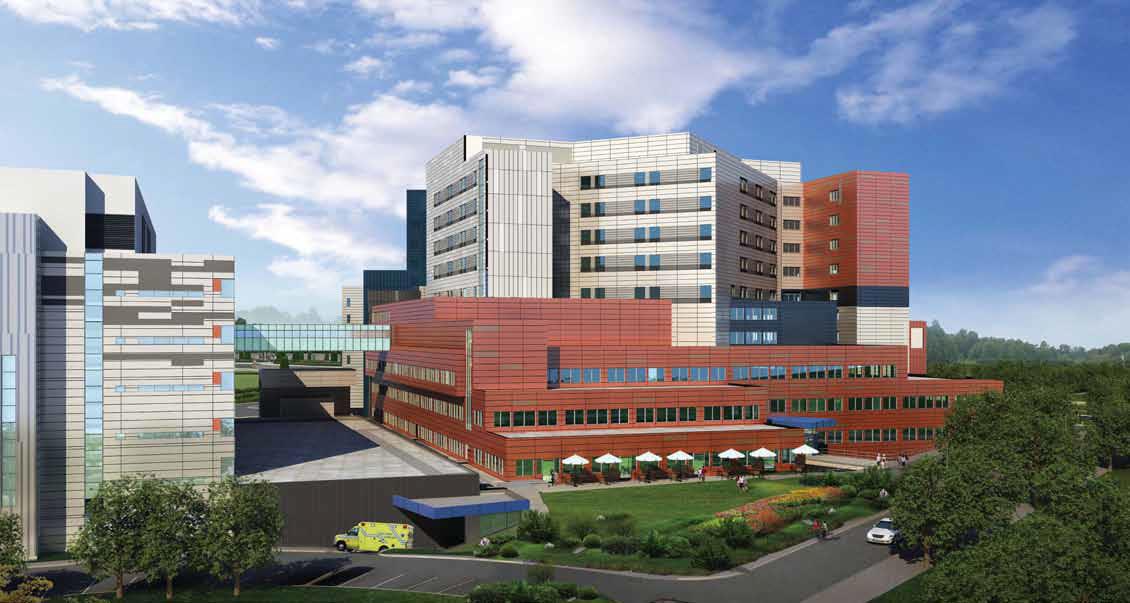
McGill University Health Centre is planning to deliver a new standard of healthcare at the Glen Site in Montreal. Robert Hamilton, senior director of Glen Campus Development and Imma Franco, associate director of planning tell Richard Halfhide how.
Every once in a while a truly unique healthcare project will appear on the horizon. One such project coming into view for the people of Montreal is the McGill University Health Centre’s (MUHC) new development at the Glen Site. This iconic healthcare campus, under construction since the summer of 2010, will become one of the most technologically advanced and patient-friendly facilities in North America. It will also be a place that embraces innovation and discovery with the amalgamation of MUHC’s new world class Research Institute.
The $2.355 billion dollar project is being implemented through a public private partnership (PPP) between the MUHC and the McGill Health Infrastructure Group. The private partner has the mandate of designing, building and maintaining the hospital complex for 30 years, although the MUHC is very much involved in the planning of the hospital complex. The Research Institute also received $100 million from the Canada Foundation for Innovation - the largest grant ever awarded by the CFI to a single institution - which was matched by $100 million in funding by the Quebec government and bolstered by $50 million from donors. Meantime, the hospital center will benefit from new equipment to the tune of $190 million.
The Glen Site is a 43 acre, 2.4 million square foot site situated a few minutes from downtown Montreal. The generous and expansive setting has allowed the designers to incorporate new homes for The Montreal Children’s Hospital, The Royal Victoria Hospital, the Montreal Chest Institute, and a new Cancer Centre as well as the aforementioned Research Institute.
The setting and position of the new facility is very deliberate and ease of public access was always a primary concern. Its alignment to commuter rail, subway and 11 bus lines plus four major highways is significant. Also of great importance is how the new development interacts with the surrounding environment, as Hamilton explains. “Coming onto the site from the public realm and surrounding urban neighborhoods, there’s a very natural step down into a large amount of green space facing the main entrance. This leads to a generous simple and intuitive network of interior streets and atria. It achieves clarity of movement that is extremely simple and well resolved.”
The facility as a whole will cater to many specialized departments, each with very different functions and practices. Each individual pavilion will carry an approximate footprint of 40,000 square feet spread across four to twelve floors. The genius within this part of the design is how each individual center interconnects with the next, simplifying the movements and flow of care givers and professionals alike. There is also a dual benefit in terms of way finding practicalities for patients and their families, another example of the patient being the primary concern.
“The whole facility has been laid out with patients, their families and staff in mind. We created a back of house spine where only staff, patients on stretchers and materials handling will travel so we’ve essentially separated the flows from the public, which enhances the patient-centered experience,” says Franco. Hamilton adds that “the balance between a demanding technological healthcare program and respecting the neighborhood and public experience has been really successfully achieved.”
The overall design is littered with examples of patient-centered practices, with multiple benefits from the use of green space to the vast amount of natural light used throughout the buildings. Such aspects work in favor of the patient by the creation of a calm healing environment, but also count toward the sustainable nature of the project which is aiming for LEED Silver status. Another standout feature is that the whole campus will feature single bed rooms, something that very few healthcare facilities on this scale can boast.
“We believe this is a visionary approach in which we are leading the way compared to many sister institutions in North America,” states Hamilton. “From an evidence-based design perspective it’s associated with better quality interaction between patient and care giver, lower stress for the patient, shorter stays, and better recovery. A model absolutely in favor of the patient.”
The way the design works for the care givers is also of paramount importance to any successful and efficient healthcare facility. This is well evidenced at the MUHC. The deliberate proximity of related and shared services, ergonomic spaces and core technologies will encourage shared best practice across clinical departments as well as having dual benefits for teaching and research. One example of this in practice is in the linear design of the Emergency department, whereby the separate pediatric and adult ERs have the flexibility to expand and contract, allowing for extra space in any given area dependent on demand.
“There’s been a lot of emphasis on key adjacencies with a view to enhancing collaboration between teams and simplify the patient experience. For example, the Emergency rooms are vertically adjacent to the imaging services and the operating suites. These are linked by patient transfer elevators including a trauma elevator, and in turn the ORs are horizontally adjacent to the critical care unit,” explains Franco.
Looking in from the outside, it is easy to admire the detail within the design and applaud the various healthcare design specialists and architects responsible. It does however come as a surprise to discover that this process was conducted over several years and was the result of expansive consultation with a vast spectrum of stakeholders. “There was an exhaustive and extensive design and development phase where we engaged some 500 clinicians and over 80 user groups that worked through design and development. All of those folks have been intrinsically involved in the evolutions of the design of their spaces and they are now our champions,” says Franco. This level of consultation has meant that the project has become truly inclusive and perhaps goes some way to explaining why it has received such vocal support from those within MUHC and also the community at large.
Everything the MUHC does seems to have the patient and wider community as the primary concern. Therefore the emphasis on education going hand in hand with the daily workings of the hospital is a natural one. One of the objectives from the very start has been to create an academic medical center that integrates providing the best medical care alongside integrated teaching and research services. Hamilton is very clear on the obvious benefit of such a model. “Our unique model will allow us to deliver on what we are very good at—bringing research innovation from bench to bedside.”
The current plans are for construction to be complete by the end of 2014, and for the summer of 2015 to see the first patients to benefit from the new complex. Its very nature as an academic medical center means that it represents the future of healthcare for the province of Quebec. The current plans also allow for MUHC Glen Site to grow and develop further within the land on which it sits, meaning that as the new building settles into its environment, it has room to grow in harmony with the city around it.
DOWNLOAD
 MUHC-AM-Bro-s.pdf
MUHC-AM-Bro-s.pdf













